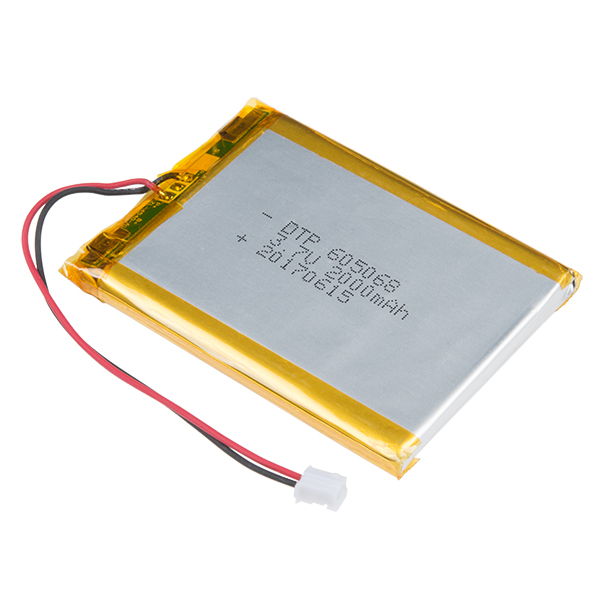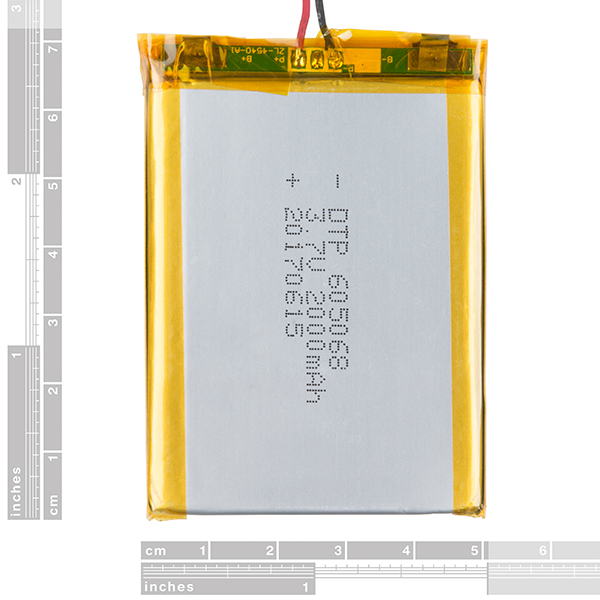These are very slim, extremely light weight batteries based on Lithium Ion chemistry. Each cell outputs a nominal 3.7V at 2000mAh! Comes terminated with a standard 2-pin JST-PH connector - 2mm spacing between pins. These batteries require special charging. Do not attempt to charge these with anything but a specialized Lithium Polymer charger.
Battery includes built-in protection against over voltage, over current, and minimum voltage. Please use caution when using this battery in wearable projects. When using conductive thread, a short in the thread can create sparks and heat. We recommend using coin cell batteries for beginners.
Note: This battery is not available to ship to Alaska or Hawaii, or through any express services (2-day, overnight), or internationally. This is temporary! Check out our blog post for more information. Additionally orders may take longer to process and therefore do not qualify for same-day shipping. Sorry for any inconvenience this may cause!
Note: This item is non-returnable. If this item arrives damaged or is not functioning properly, please do not hesitate to contact us to see if further actions may be taken.
- Excellent long-term self-discharge rates (<8% per month)
- Robust power source under extreme conditions (-25 to 60C)
- Dimensions: 5.6mm x 49.2mm x 68.8mm
- Weight: 36g (1.27oz)
Lithium Ion Battery - 2Ah Product Help and Resources
LiPo USB Charger Hookup Guide
May 1, 2014
How to charge your LiPo batteries with the USB LiPo charger. Plus how to modify your charger to set the charge current.
Sunny Buddy Solar Charger V13 Hookup Guide
October 13, 2014
How to hookup the Sunny Buddy: a solar-powered, MPPT (peak-power tracking), LiPo battery charger.
SparkFun 5V/1A LiPo Charger/Booster Hookup Guide
September 28, 2017
This tutorial shows you how to hook up and use the SparkFun 5V/1A LiPo Charger/Booster circuit.
Battery Technologies
February 6, 2013
The basics behind the batteries used in portable electronic devices: LiPo, NiMH, coin cells, and alkaline.
LilyPad Basics: Powering Your Project
September 24, 2018
Learn the options for powering your LilyPad projects, LiPo battery safety and care, and how to calculate and consider power constraints on your projects.
LiPo Charger Plus Hookup Guide
May 30, 2019
This tutorial shows you how to hook up and use the SparkFun LiPo Charger Plus board.
Single Cell LiPo Battery Care
March 16, 2023
This tutorial will go over how to safely charge, connect, disconnect, reinforcing the cables, and handle single cell LiPo batteries.
Adjustable LiPo Charger Hookup Guide
September 28, 2017
The SparkFun Adjustable LiPo Charger is a single-cell lithium polymer (LiPo) and lithium ion battery charger. Because it’s adjustable, this charger will be able to safely charge all of our singe-cell batteries.
LiPo Fuel Gauge (MAX1704X) Hookup Guide
February 23, 2023
Monitor your LiPo battery with the LiPo fuel gauge! In this tutorial, we will be using the MAX17043 and MAX17048 to monitor a single cell, LiPo battery over the Arduino Serial Monitor. We will also connect a display to view the output without the need to connect the microcontroller to a computer.
Core Skill: Electrical Prototyping
If it requires power, you need to know how much, what all the pins do, and how to hook it up. You may need to reference datasheets, schematics, and know the ins and outs of electronics.
Skill Level: Competent - You will be required to reference a datasheet or schematic to know how to use a component. Your knowledge of a datasheet will only require basic features like power requirements, pinouts, or communications type. Also, you may need a power supply that?s greater than 12V or more than 1A worth of current.
See all skill levels
Comments
Looking for answers to technical questions?
We welcome your comments and suggestions below. However, if you are looking for solutions to technical questions please see our Technical Assistance page.
Customer Reviews
4.6 out of 5
Based on 9 ratings:
2 of 2 found this helpful:
Solid performance lithium battery
This is a good battery for replacing failing batteries in small low drain devices like radio, phone, Mp3s players. I did find that the 2000 mAh rating is assuming a less than 500 mA discharge rate as anything over that begins to drag the capacity lower and a 1A discharge rate reports closer to 1450 mAh than 2000. I would avoid use in high drain devices.
1 of 1 found this helpful:
So far so good.
I bought this battery to use in a pair of wireless bluetooth headphones I'm building. I have not finished the project yet, but over the past 3 weeks I have used this battery to test my circuits and haven't had to charge it yet. It seems that this holds a charge really well and delivers a consistent 3.7 volts. It is rather large which has the potential to create design problems if you are looking to include this in a self contained project, but it is still manageable, especially if you need a thin battery.
Works as expected.
The battery worked as expected.
0 of 1 found this helpful:
Works great as advertised
Incredibly long time on a charge.
So far so good
Battery is holding up in the project so far, no complaints
A very good battery
This battery delivers at or better than the 2000mAh spec. All of the 8 batteries (from 2 different vendors) that were tested (multiple iterations of charge/discharge) performed exceptionally well under load testing. One battery failed. Root cause investigation determined that it was the "safety board" electronics that failed. Battery appears "good". (No further testing has been done on it). Note: It is possible that the battery Electronic Load (XY-FZ35) caused the safety board to fail as I was running the discharge rate very close to the published limit.
It batteries
Worked nicely with the esp32 thing
It's Alive!
Sparkfun's Lithium-Ion Batteries are reliable and consistent. I don't know what else you want from a battery. It has taken my projects from unpowered and useless to strong productive members of my robot army.
Provides power for my projects over 24 hours
I have purchased two of these batteries. One for a Blynk Board project and the other for an ESP8266 Thing - Dev Board. Each project runs for over 24 hours on battery power with typical LED's on and blinking & no sleep mode. This battery backup is just right for these projects when mains goes down. Some local power outages have lasted more than 12 hours making this battery a must. I added a JST Jumper 2 Wire Assembly, Lipo Charger Basic Micro USB & USB MicroB Plug Breakout to the Thing - Dev Board to accommodate charging this battery.



What is the maximum current draw?
Can these batteries be connected in series to provide 7.4v with 2000mAH?
I was wondering why this battery replaced this one: https://www.sparkfun.com/products/retired/8483. The other battery had great reviews, what is different about this battery to justify a new product number and page? They appear to be almost identical.
Mostly we got them for a more reliable supplier with better documentation. They should be pretty much identical, just with more documentation.
They are not identical. The old one was roughly 53mm x 62mm and this one is 50mm x 70mm, and will no longer fit for my project :(
I agree, they are not dimensionally equivalent. The added thickness doesn't fit in my enclosure. I've purchased >300 of these and now have to find a different source. Bummer, because better documentation is nearly useless.
I am trying to find a battery compatible with the Arduino Fio. Is this battery only one cell? Is there a datasheet for this battery?
Hi there, it sounds like you are looking for technical assistance. Please use the link in the banner above, to get started with posting a topic in our forums. Our technical support team will do their best to assist you.
That being said, if you are referring to battery cells as specified in this guide then this battery would be classified as a single cell battery.
Does anyone know the cutoff voltage for this battery?
We're using these batteries in the MinXSS-2 CubeSat which should be launched into orbit in 2018 October! Is there a datasheet? I see the MSDS and the connector sheet... but not the regular datasheet.
Is there any data on the parasitic losses from the on-board circuitry? I am sourcing batteries for a outdoor solar-recharged project with limited solar capacity so every point of loss is very important.